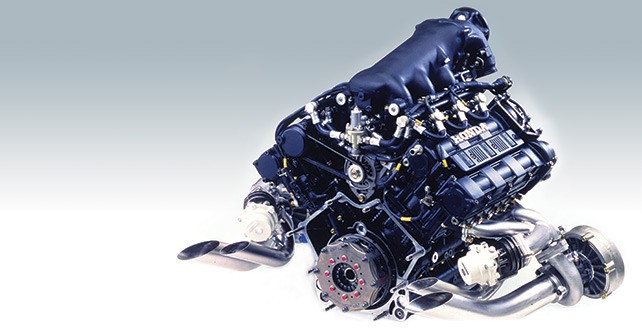
Is Formula 1 headed to a return to twin-turbo V-6 engines like this Honda 1.5 litre unit from 1988?
When I think of Formula 1, I think of it as a business first and then a sport. Nevertheless, clutching onto the latter, I think the sporting spectacle should be good in 2015 (as a follow on from 2014) – with the Mercedes boys fighting between themselves, while Ferrari, Red Bull Racing and others figure out how to join the battle. The added benefit for fans being the confirmation of a ‘twentieth’ race in the 2015 F1 calendar.
On the business front, unfortunately, many familiar issues can be expected to steal the limelight from time-to-time – the precarious financial health of the non-historic (mid-field) teams, the muted sound of the engines, the expense of developing these new engines, race organisers struggling to sell tickets, etc. Along the way, expect a few lousy statements from a certain Mr. E on how the sport doesn’t need social media and the rush of younger generation viewers that it could easily attract at no extra cost. And, of course, the inability of teams and the sport to attract non-Latin American (or Mexican) sponsors!
This is a very strange phenomenon. Formula 1 takes pride in being the pinnacle of motorsport, amongst other ‘tags’ (most viewed category in motorsport too), but it has consistently failed to woo multinationals that have deflected their millions to other sport – not to mention that they’ve been unable to attract manufacturers (with the exception of Honda) even with their radical hybrid formula for the sport. In comparison, the recent World Endurance Championship launched by the FIA has participation from a variety of manufacturers across multiple classes that include Toyota, Audi, and Porsche, among others.
Yet, the changes that the sport wishes to embark on are technical, rather than commercial or marketing driven. Changes that I would classify as being invisible to the fan, focusing on cost reduction and the like – which, while important, wouldn’t exactly attract fans back to the sport (and yes, far too many fans have left us already).
In yet another attempt to attract fans (or destabilize the sport, in my view), a new engine formula for 2017 (or earlier) is being discussed. And while I believe that moving from the new hybrid technology would be a PR disaster for the automobile manufacturers involved (Ferrari and Mercedes largely), fans would be excited by the prospect of 1,000bhp engines making a return.
The general view of cars designed under the 2014 regulations is that they are easier to drive and less physically demanding than their predecessors. The balance has tilted way too much towards strategy and efficiency (as Alan McNish expressed recently), and less towards driving the cars flat out on the ‘edge of adhesion.’ His observation from a young driver test, in which three or four rookies jumped straight into F1 cars and were on the pace immediately, supports this theory and encourages the reintroduction of more powerful and edgier engines in future.
The other change (non-sporting, non-commercial) that the sport will undergo is regarding the process of awarding a super-license to upcoming drivers. The FIA has announced a points system for junior drivers to accumulate via participation and performance in the junior formulae before considering themselves eligible for a Formula 1 seat. A system for selecting future Formula 1 drivers does add some much needed structure to the sport (reference a previous column, Let’s Build A Better Sport, in the Feb 2013 issue), but of course this too isn’t without controversy!
The system ensures that a driver riding on bags of money doesn’t barge his way into the sport – which, I guess, all stakeholders (barring future ‘pay drivers’) ought to be happy about. Apart from that, there are a few negatives that need to be ironed out immediately. For starters, the sport may lose out on prodigies like Kimi Raikkonen who debuted in Formula 1 after competing in a little more than twenty races in Formula Renault. And it would hamper the return of racers (champions more often than not) should they decide to take a break and return, like Raikkonen and Schumacher.
Secondly, the actual points structure leaves much to be desired. The yet to-be launched FIA series (F2) has been given more prominence over the currently established series such as GP2 and Formula Renault. The cheaper, and far more competitive, alternative championships on the ladder to Formula 1 have been given a raw deal. Whatever be the outcome, the biggest beneficiary will be Max Verstappen who will keep the tag of ‘youngest driver to debut in Formula 1’ for a long, long time…
Read Kunal’s views at his F1 blog.

















Write your Comment